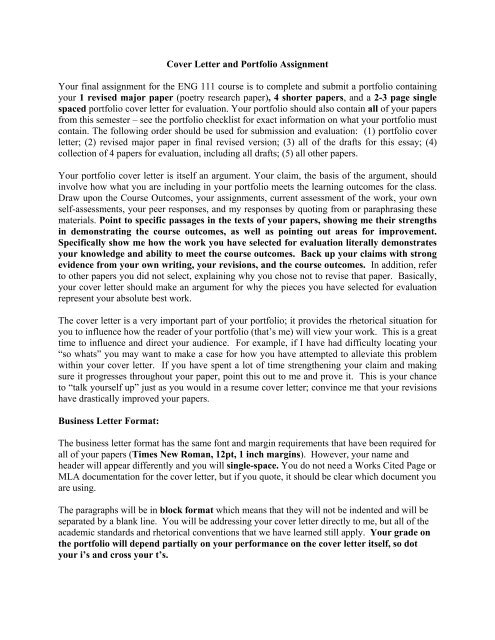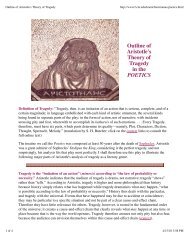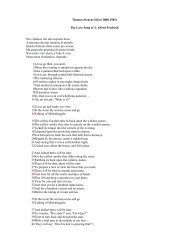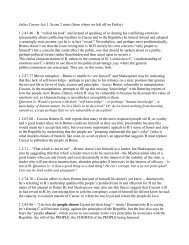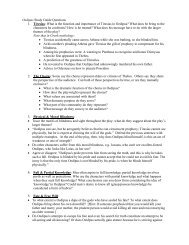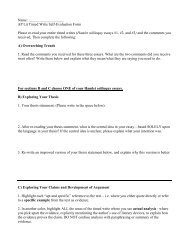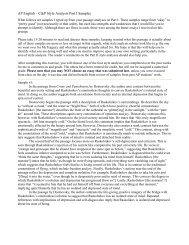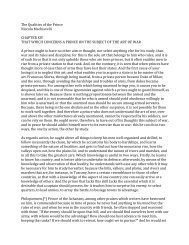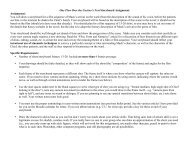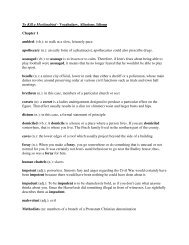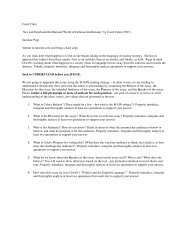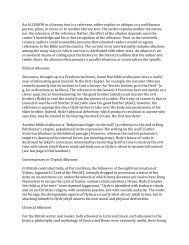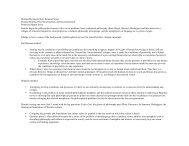Cover Letter and Portfolio Assignment Your final assignment for the ...
Cover Letter and Portfolio Assignment Your final assignment for the ...
Cover Letter and Portfolio Assignment Your final assignment for the ...
You also want an ePaper? Increase the reach of your titles
YUMPU automatically turns print PDFs into web optimized ePapers that Google loves.
<strong>Cover</strong> <strong>Letter</strong> <strong>and</strong> <strong>Portfolio</strong> <strong>Assignment</strong><br />
<strong>Your</strong> <strong>final</strong> <strong>assignment</strong> <strong>for</strong> <strong>the</strong> ENG 111 course is to complete <strong>and</strong> submit a portfolio containing<br />
your 1 revised major paper (poetry research paper), 4 shorter papers, <strong>and</strong> a 2-3 page single<br />
spaced portfolio cover letter <strong>for</strong> evaluation. <strong>Your</strong> portfolio should also contain all of your papers<br />
from this semester – see <strong>the</strong> portfolio checklist <strong>for</strong> exact in<strong>for</strong>mation on what your portfolio must<br />
contain. The following order should be used <strong>for</strong> submission <strong>and</strong> evaluation: (1) portfolio cover<br />
letter; (2) revised major paper in <strong>final</strong> revised version; (3) all of <strong>the</strong> drafts <strong>for</strong> this essay; (4)<br />
collection of 4 papers <strong>for</strong> evaluation, including all drafts; (5) all o<strong>the</strong>r papers.<br />
<strong>Your</strong> portfolio cover letter is itself an argument. <strong>Your</strong> claim, <strong>the</strong> basis of <strong>the</strong> argument, should<br />
involve how what you are including in your portfolio meets <strong>the</strong> learning outcomes <strong>for</strong> <strong>the</strong> class.<br />
Draw upon <strong>the</strong> Course Outcomes, your <strong>assignment</strong>s, current assessment of <strong>the</strong> work, your own<br />
self-assessments, your peer responses, <strong>and</strong> my responses by quoting from or paraphrasing <strong>the</strong>se<br />
materials. Point to specific passages in <strong>the</strong> texts of your papers, showing me <strong>the</strong>ir strengths<br />
in demonstrating <strong>the</strong> course outcomes, as well as pointing out areas <strong>for</strong> improvement.<br />
Specifically show me how <strong>the</strong> work you have selected <strong>for</strong> evaluation literally demonstrates<br />
your knowledge <strong>and</strong> ability to meet <strong>the</strong> course outcomes. Back up your claims with strong<br />
evidence from your own writing, your revisions, <strong>and</strong> <strong>the</strong> course outcomes. In addition, refer<br />
to o<strong>the</strong>r papers you did not select, explaining why you chose not to revise that paper. Basically,<br />
your cover letter should make an argument <strong>for</strong> why <strong>the</strong> pieces you have selected <strong>for</strong> evaluation<br />
represent your absolute best work.<br />
The cover letter is a very important part of your portfolio; it provides <strong>the</strong> rhetorical situation <strong>for</strong><br />
you to influence how <strong>the</strong> reader of your portfolio (that’s me) will view your work. This is a great<br />
time to influence <strong>and</strong> direct your audience. For example, if I have had difficulty locating your<br />
“so whats” you may want to make a case <strong>for</strong> how you have attempted to alleviate this problem<br />
within your cover letter. If you have spent a lot of time streng<strong>the</strong>ning your claim <strong>and</strong> making<br />
sure it progresses throughout your paper, point this out to me <strong>and</strong> prove it. This is your chance<br />
to “talk yourself up” just as you would in a resume cover letter; convince me that your revisions<br />
have drastically improved your papers.<br />
Business <strong>Letter</strong> Format:<br />
The business letter <strong>for</strong>mat has <strong>the</strong> same font <strong>and</strong> margin requirements that have been required <strong>for</strong><br />
all of your papers (Times New Roman, 12pt, 1 inch margins). However, your name <strong>and</strong><br />
header will appear differently <strong>and</strong> you will single-space. You do not need a Works Cited Page or<br />
MLA documentation <strong>for</strong> <strong>the</strong> cover letter, but if you quote, it should be clear which document you<br />
are using.<br />
The paragraphs will be in block <strong>for</strong>mat which means that <strong>the</strong>y will not be indented <strong>and</strong> will be<br />
separated by a blank line. You will be addressing your cover letter directly to me, but all of <strong>the</strong><br />
academic st<strong>and</strong>ards <strong>and</strong> rhetorical conventions that we have learned still apply. <strong>Your</strong> grade on<br />
<strong>the</strong> portfolio will depend partially on your per<strong>for</strong>mance on <strong>the</strong> cover letter itself, so dot<br />
your i’s <strong>and</strong> cross your t’s.
<strong>Portfolio</strong> Reminders<br />
1. Even if you did well on <strong>the</strong> initial draft of your chosen <strong>assignment</strong>s, you MUST<br />
SIGNIFICANTLY REVISE each paper you include in <strong>the</strong> portfolio. Remember, fulfilling<br />
Outcomes 4a <strong>and</strong> 4b depends on this. Significant revision means substantial changes to <strong>the</strong><br />
structure of your paper, <strong>the</strong> evidence used in your argument, <strong>and</strong>/or <strong>the</strong> claims or sub-claims that<br />
have been made. You are also welcome to bring in additional sources if you feel it streng<strong>the</strong>ns<br />
your argument (tell me how in <strong>the</strong> cover letter). Editing <strong>and</strong> proofreading <strong>for</strong> grammar,<br />
mechanics, <strong>and</strong> word choice does not equal significant revision, though it is a part of Outcome 4c.<br />
I guarantee that none of your papers has been so perfect that it cannot benefit from significant<br />
revision. My comments may only indicate starting points <strong>for</strong> this <strong>and</strong> revising purely in terms of<br />
<strong>the</strong>m will not guarantee an “A” so it is essential that you confront every paper in terms of your<br />
underst<strong>and</strong>ing of <strong>the</strong> Outcomes. Of course, you can conference with me about any ideas you<br />
have <strong>for</strong> revision.<br />
2. Keep an eye on length requirements, particularly <strong>the</strong> minimums. Length requirements will be<br />
an important part of future classes, so this is good practice.<br />
3. Make sure you have followed <strong>the</strong> <strong>for</strong>mat requirements, especially MLA citation, which<br />
includes paren<strong>the</strong>tical citations <strong>and</strong> a properly <strong>for</strong>matted Works Cited Page.<br />
4. Go back <strong>and</strong> review your notes, all comments <strong>and</strong> <strong>the</strong> various h<strong>and</strong>outs that I have given you.<br />
These can be useful in helping you to look at your work in new ways.<br />
Exactly How to Organize <strong>Your</strong> <strong>Portfolio</strong><br />
Turn your portfolio in to me with <strong>the</strong> <strong>assignment</strong>s included in <strong>the</strong> following order. Each <strong>assignment</strong> (<strong>and</strong><br />
its revised edition if applicable) MUST be stapled individually. NO exceptions!<br />
Create your portfolio with all documents in <strong>the</strong> following order:<br />
<strong>Assignment</strong>s to be evaluated<br />
____ <strong>Cover</strong> letter<br />
____ 1 Major paper <strong>for</strong> evaluation (Place <strong>the</strong> revised edition directly on top of your original copy. Place<br />
your peer review sheets (2) behind <strong>the</strong> original copy)<br />
____ 4 Shorter papers <strong>for</strong> evaluation (Place <strong>the</strong> revised edition directly on top of your original copy).<br />
All o<strong>the</strong>r <strong>assignment</strong>s<br />
____ O<strong>the</strong>r smaller papers (organize <strong>the</strong>se in date order).<br />
____ O<strong>the</strong>r major take-home paper<br />
General <strong>Portfolio</strong> Requirements<br />
• Place your completed portfolio in a manila envelope.<br />
• Make sure your name is clearly visible on <strong>the</strong> outside of <strong>the</strong> manila envelope.<br />
• All portfolios must be delivered to me IN PERSON.<br />
• <strong>Portfolio</strong>s are due Wednesday, May 30 th by 1:55 pm, NO exceptions.
<strong>Portfolio</strong> Must Haves - Checklist<br />
A complete portfolio absolutely must contain <strong>the</strong> following elements:<br />
For Evaluation<br />
N.B. The evaluated portion of <strong>the</strong> portfolio will be graded as a whole. This means that every<br />
<strong>assignment</strong> need not fulfill every outcome. Ra<strong>the</strong>r, your must demonstrate your proficiency in<br />
fulfilling every outcome somewhere within your 4 smaller papers <strong>and</strong> 1 large paper. For<br />
example, you may want to use one small <strong>assignment</strong> simply to demonstrate your mastery of<br />
outcome three. This is fine, <strong>and</strong> you would want to alert me to this fact in your cover letter.<br />
____ <strong>Cover</strong> <strong>Letter</strong> (2-3 pages single spaced, business letter <strong>for</strong>mat)<br />
____ 4 shorter papers that have been significantly revised (in-class essays are obviously fair<br />
game – revised papers need to be typed; must be at least two pages each)<br />
____ 1 major poetry research paper that has been significantly revised (must be at least five<br />
pages; no longer than 8 pages)<br />
All o<strong>the</strong>r papers (All original drafts with instructor/reader comments)<br />
____ Heart of Darkness Major Paper<br />
____ Hamlet Essay<br />
____ “The Flea” Poetry Analysis<br />
____ One Flew over <strong>the</strong> Cuckoo’s Nest Essay<br />
____ “The Broken Heart” Poetry Essay<br />
____ Donne/Marvell Poetry Essay<br />
____ Blake’s Chimney Sweepers Poetry Essay<br />
____ Keats/Frost Poetry Essay<br />
____ “The Birthday Party” Style Analysis Essay<br />
____ The Metamorphosis Essay<br />
____ “The Pupil” Style Analysis Essay<br />
____ “The O<strong>the</strong>r Paris” Style Analysis Essay<br />
____ Dickinson/Frost Poetry Essay<br />
____ “One Art” Poetry Essay<br />
____ Major Poetry Research Paper<br />
Any portfolio that does not include ALL of <strong>the</strong> above will be considered<br />
INCOMPLETE. Fur<strong>the</strong>rmore, any portfolio in which <strong>the</strong> <strong>assignment</strong>s fall significantly<br />
short of <strong>the</strong>ir length or content requirements will also be considered incomplete.<br />
AN INCOMPLETE PORTFOLIO GUARANTEES A FAILING GRADE IN THE CLASS!<br />
DON’T LET THIS HAPPEN TO YOU!
ENGLISH 111 COURSE OUTCOMES<br />
1. To produce complex, analytic, persuasive arguments that matter in academic contexts.<br />
• The argument is appropriately complex, based in a claim that emerges from <strong>and</strong> explores<br />
a line of inquiry.<br />
• The stakes of <strong>the</strong> argument, why what is being argued matters, are articulated <strong>and</strong><br />
persuasive.<br />
• The argument involves analysis, which is <strong>the</strong> close scrutiny <strong>and</strong> examination of evidence<br />
<strong>and</strong> assumptions in support of a larger set of ideas.<br />
• The argument is persuasive, taking into consideration counterclaims <strong>and</strong> multiple points<br />
of view as it generates its own perspective <strong>and</strong> position.<br />
• The argument utilizes a clear organizational strategy <strong>and</strong> effective transitions that<br />
develop its line of inquiry.<br />
2. To read, analyze, <strong>and</strong> syn<strong>the</strong>size complex texts purposefully in order to generate <strong>and</strong> support<br />
writing.<br />
• The writing demonstrates an underst<strong>and</strong>ing of <strong>the</strong> course texts as necessary <strong>for</strong> <strong>the</strong><br />
purpose at h<strong>and</strong>.<br />
• Course texts are used in strategic, focused ways (<strong>for</strong> example: summarized, cited,<br />
applied, challenged, re-contextualized) to support <strong>the</strong> goals of <strong>the</strong> writing.<br />
• The writing is intertextual, meaning that a "conversation" between texts <strong>and</strong> ideas is<br />
created in support of <strong>the</strong> writer's goals.<br />
• The writing demonstrates responsible use of <strong>the</strong> MLA system of documenting sources.<br />
3. To demonstrate an awareness of <strong>the</strong> strategies that writers use in different rhetorical situations.<br />
• The writing employs style, tone, <strong>and</strong> conventions appropriate to <strong>the</strong> dem<strong>and</strong>s of a<br />
particular genre, rhetorical situation or discipline.<br />
• The writing has a clear underst<strong>and</strong>ing of its audience, <strong>and</strong> various aspects of <strong>the</strong> writing<br />
(mode of inquiry, content, structure, evidence, appeals, tone, sentences, <strong>and</strong> word choice)<br />
address <strong>and</strong> are strategically pitched to that audience.<br />
• The writer recognizes <strong>and</strong> articulates <strong>the</strong> effects of his or her rhetorical choices.<br />
4. To develop flexible strategies <strong>for</strong> revising, editing, <strong>and</strong> proofreading writing.<br />
• The writing demonstrates substantial <strong>and</strong> successful revision.<br />
• The writing responds to substantive issues raised by <strong>the</strong> instructor <strong>and</strong> peers.<br />
• Errors of grammar, punctuation, <strong>and</strong> mechanics are proofread <strong>and</strong> edited so as not to<br />
interfere with reading <strong>and</strong> underst<strong>and</strong>ing <strong>the</strong> writing.
English 111 <strong>Portfolio</strong> Evaluation Rubric<br />
Outst<strong>and</strong>ing <strong>Portfolio</strong> (3.7-4.0)<br />
This portfolio exhibits outst<strong>and</strong>ing proficiency in all outcomes categories – academic<br />
argumentation, purposeful use of texts, rhetorical awareness, <strong>and</strong> revision, editing, <strong>and</strong><br />
proofreading – outweighing its few weaknesses. The cover letter clearly indicates which items in<br />
<strong>the</strong> portfolio demonstrate <strong>the</strong> course outcomes, <strong>and</strong> makes a compelling argument <strong>for</strong> how <strong>the</strong>y<br />
do so. In so doing, it displays thorough <strong>and</strong> thoughtful awareness of <strong>the</strong> writer’s own writing,<br />
using evidence from <strong>the</strong> course outcomes, <strong>assignment</strong>s, self-assessments, peer responses, <strong>and</strong><br />
teacher responses by quoting or paraphrasing from <strong>the</strong>se materials in support of its argument.<br />
The selected major paper <strong>and</strong> shorter texts offer an outst<strong>and</strong>ing demonstration of all <strong>the</strong> course<br />
outcomes through a very highly proficient <strong>and</strong> skillful h<strong>and</strong>ling of <strong>the</strong> traits associated with<br />
<strong>the</strong>m. The outst<strong>and</strong>ing portfolio will likely demonstrate some appropriate risk-taking,<br />
originality, variety, <strong>and</strong>/or creativity.<br />
Strong <strong>Portfolio</strong> (3.1-3.6)<br />
The strong portfolio exhibits strengths clearly outweighing weaknesses, but may show<br />
somewhat less proficiency in one or two of <strong>the</strong> outcomes categories, perhaps strong in academic<br />
argumentation, purposeful use of texts, <strong>and</strong> rhetorical awareness, but slightly less in<br />
revision/editing/proofreading. The cover letter clearly indicates which items in <strong>the</strong> portfolio<br />
demonstrate <strong>the</strong> course outcomes, <strong>and</strong> makes an effective argument <strong>for</strong> how <strong>the</strong>y do so. It also<br />
displays thoughtful awareness of <strong>the</strong> writer’s own writing, using evidence from <strong>the</strong> course<br />
outcomes, <strong>assignment</strong>s, self-assessments, peer responses, <strong>and</strong> teacher responses by quoting or<br />
paraphrasing from <strong>the</strong>se materials in support of its argument, but may not present as clear an<br />
argument <strong>for</strong> <strong>the</strong> choices as <strong>the</strong> outst<strong>and</strong>ing portfolio. The selected major paper <strong>and</strong> shorter<br />
texts, although slightly less consistent in demonstrating <strong>the</strong> course outcomes, none<strong>the</strong>less offer a<br />
strong demonstration of effectiveness in many traits associated with <strong>the</strong> outcomes, h<strong>and</strong>ling a<br />
variety of tasks successfully. This portfolio engages <strong>the</strong> material <strong>and</strong> follows <strong>the</strong> <strong>assignment</strong>s<br />
given, but may risk less than <strong>the</strong> outst<strong>and</strong>ing portfolio.<br />
Good <strong>Portfolio</strong> (2.5-3.0)<br />
The good portfolio also exhibits strengths outweighing weaknesses, but may show less<br />
strength in two of <strong>the</strong> outcomes categories, perhaps strong in academic argumentation <strong>and</strong><br />
purposeful use of texts, but less so in revision, editing, proofreading, <strong>and</strong> rhetorical awareness.<br />
The cover letter indicates which items in <strong>the</strong> portfolio demonstrate <strong>the</strong> course outcomes, <strong>and</strong><br />
makes an argument <strong>for</strong> how <strong>the</strong>y do so, although <strong>the</strong> argument may display less thoughtful<br />
awareness of <strong>the</strong> writer’s own writing by using less evidence from <strong>the</strong> course outcomes,<br />
<strong>assignment</strong>s, self-assessments, peer responses, <strong>and</strong> teacher responses in support of its argument.<br />
The selected major paper <strong>and</strong> shorter texts effectively demonstrate <strong>the</strong> course outcomes, but with<br />
less proficiency <strong>and</strong> control. The portfolio usually will not display <strong>the</strong> appropriate risk-taking<br />
<strong>and</strong> creativity of <strong>the</strong> strong <strong>and</strong> outst<strong>and</strong>ing portfolios.<br />
Acceptable <strong>Portfolio</strong> (2.0-2.4)<br />
The acceptable portfolio is competent, demonstrating that <strong>the</strong> course outcomes are<br />
basically met, but <strong>the</strong> traits associated with <strong>the</strong>m are not as fully realized or controlled. The<br />
writing can succeed in <strong>the</strong> academic environment. The strengths <strong>and</strong> weaknesses are about<br />
evenly balanced, but should be slightly stronger on academic argument <strong>and</strong> purposeful use of<br />
texts, as <strong>the</strong>se represent key facets of academic writing. Some parts of <strong>the</strong> selected texts may be<br />
underdeveloped, too general, or predictable, or leave parts of <strong>the</strong> outcomes unconsidered. While
demonstrating knowledge of conventions, this portfolio typically will not display rhetorical<br />
awareness or control over revision, editing, <strong>and</strong> proofreading. The cover letter indicates which<br />
items in <strong>the</strong> portfolio demonstrate <strong>the</strong> course outcomes, but may not make as effective an<br />
argument <strong>for</strong> how <strong>the</strong>y do so, one based in evidence from <strong>the</strong> course outcomes, <strong>assignment</strong>s,<br />
self-assessments, peer responses, <strong>and</strong> teacher responses.<br />
Inadequate <strong>Portfolio</strong> (1.0-1.9)<br />
A portfolio will be inadequate when it shows serious deficiencies in three of <strong>the</strong> four<br />
course outcomes, especially in academic argument, purposeful use of texts, <strong>and</strong> revision, editing,<br />
<strong>and</strong> proofreading (<strong>for</strong> example, revision is limited to correcting grammar or to adding or deleting<br />
sentence <strong>and</strong> phrase level changes). Alternatively, this portfolio may be error free, yet does not<br />
adequately demonstrate <strong>the</strong> o<strong>the</strong>r outcomes. The portfolio cover letter will be brief <strong>and</strong> may not<br />
indicate which items in <strong>the</strong> portfolio demonstrate <strong>the</strong> course outcomes or make an effective<br />
argument <strong>for</strong> how <strong>the</strong>y do so. The portfolio indicates that <strong>the</strong> student may need more time to be<br />
able to h<strong>and</strong>le <strong>the</strong> dem<strong>and</strong>s of both academic reading <strong>and</strong> writing as characterized in <strong>the</strong> course<br />
outcomes <strong>and</strong> associated traits.<br />
Incomplete <strong>Portfolio</strong> (0.0-0.9)<br />
The incomplete portfolio covers <strong>the</strong> range from no portfolio turned in (0.0), to <strong>the</strong><br />
portfolio that includes only part of <strong>the</strong> required work <strong>for</strong> <strong>the</strong> class, a portfolio missing significant<br />
portions of <strong>the</strong> work <strong>for</strong> <strong>the</strong> course.<br />
University of Washington Grading Scale<br />
(taken from http://www.washington.edu/students/gencat/front/Grading_Sys.html)<br />
A 4.0-3.9<br />
A- 3.8-3.5<br />
B+ 3.4-3.2<br />
B 3.1-2.9<br />
B- 2.8-2.5<br />
C+ 2.4-2.2<br />
C 2.1-1.9 2.0 or above is required <strong>for</strong> <strong>the</strong> “C” credit<br />
C- 1.8-1.5<br />
D+ 1.4-1.2<br />
D 1.1-0.9<br />
D- 0.8-0.7 Lowest passing grade.<br />
E 0.0 Failure or Unofficial Withdrawal.<br />
No credit earned.


